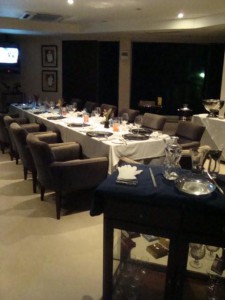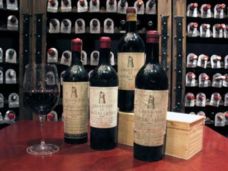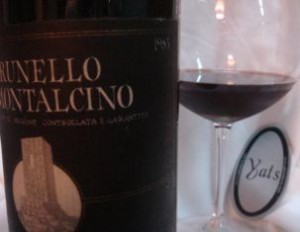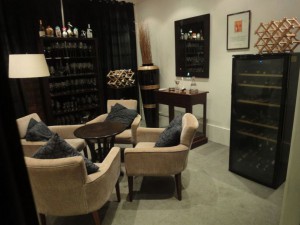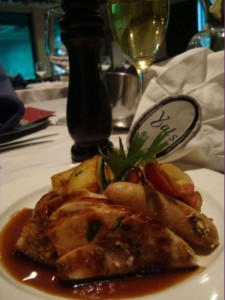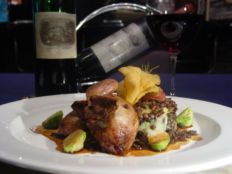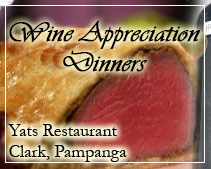History of Dry Aging-July 26,2011
Our legendary Dry Aged steaks are hand selected and hand cut by our master dry agers. Dry aging is an art that requires extensive training and knowledge. The result is a steak that is bolder, more tender, with a buttery succulence found only in our Dry Aged steaks.
The dry aging process takes special care and requires a relatively large inventory. It is very time consuming and expensive, requiring extra effort, storage and high-quality beef. Up to 20% of the original weight of the loin is lost during the dry aging process. This is why dry aged steak is offered only in fine restaurants, upscale grocery stores and gourmet steak companies.
Definition of Dry Aged Beef: Forty years ago, most of our beef was dry aged. In the early 1960′s the process of vacuum packing beef became the norm for most processors. The advantage of this process was that they could “wet age” the beef in the bag and not lose any of the weight of the beef. Wet aging was much more cost effective for the processors so a weaning of the consumers’ taste buds began to occur. Slowly, the consumer forgot what the real taste of steak was… Our dry aging process begins with the finest premium choice loins, hung in a climate and humidity controlled room. The beef is aged for a minimum of 21 days. During this process a crust forms on the outside of the loin, very similar to the texture of beef jerky. This layer is trimmed away, leaving steaks that are superior in tenderness and flavor. During the dry aging process, the juices are absorbed into the meat, enhancing the flavor and tenderizing the steaks. Research from major universities, including Kansas State University, indicates the enhancement of flavor and tenderness occurs in this Dry Aging process. Dry Aged Steaks are very popular in the fine, white linen steakhouses on the coasts.
Latour lineup in cellar
Does freezing a steak affect the taste?
Extensive research by Oklahoma State University and Kansas State University indicates that flash freezing of a steak preserves the flavor, and in fact, even the most discriminating chef could not tell the difference.
Aging Beef
Richard J. Epley
The aging of beef is normally thought of as the time, in days, from slaughter until the carcass is broken down into retail cuts. The average industry time for aging beef before cutting the carcass into retail cuts is about seven days. Consumers can use the following guidelines in determining the length of time their beef should be aged.
What Aging Does
Cooked, unaged beef has been described as “metallic” and lacking in typical beef flavor. Aging gives beef a flavor that has been described as “gamy.” True beef flavor is fully developed after about 11 days of aging. The aged beef flavor increases with increasing aging time.
Aging also increases tenderness. It has been shown that during the aging process certain changes take place in portions of the structure of collagen and muscle fibers. Currently, it is thought that enzymatic-caused changes in the structure of muscle fibers are largely responsible for the increase in tenderness. It is known that tenderness decreases immediately after slaughter while rigor mortis takes place (taking 6 to 12 hours to complete); then tenderness increases gradually. Tenderness continues to increase up to 11 days, after which there is no increase in tenderness.
One study showed that maximum tenderness and progress of tenderization during aging varies among muscles and is associated with the color of the carcass lean. In general, aging dark-cutting beef beyond seven days did little to increase tenderness. However, in carcasses where lean was lighter in color, tenderness continued to improve during up to 16 days of aging.
The tenderness effects of aging are more evident in carcasses from older animals than in the usually more tender lean from younger animals’ carcasses.
Aging also decreases the shelf life of fresh meat products. Ground beef made from trimmings from aged beef carcasses usually has a shorter shelf life in the retail case and in your refrigerator, primarily because of increased microbial growth that occurs on certain parts of the carcass during the aging process.
Some research has demonstrated that as fresh meat ages, the activity of the various enzymes decreases and protective action against oxidation declines, thus increasing susceptibility to oxidation. This suggests that oxidation of fresh raw meat becomes increasingly important the more meat is aged.
During the aging process, one can also expect a loss of weight of the product. Because the lean (exclusive of trimmable fat and bone) is approximately 70 percent water, it’s easy to see why there is a weight loss. The weight loss is caused by dehydration of the lean and fat. The weight loss occasionally occurs at tremendous proportions depending on relative humidity, amount of air flow and temperature of the aging cooler. During chilling of the hot carcass immediately after slaughter, the carcass will lose 2 to 3 percent of its weight because of moisture loss. Aging the carcass beyond this time will result in additional tissue shrinkage of 1 to 1.5 percent for each seven days. Carcasses with a thin external fat cover will lose more moisture than carcasses with a heavy fat cover. One study observed an 18 percent trim and shrink loss from loins aged 14 days in a 36 degrees F cooler.
Consumer Preference
Most of the beef offered for sale as retail cuts at supermarkets is aged from 5 to 7 days, which would be called moderately aged beef. Beef for certain restaurants is aged from 14 to 21 days, primarily to obtain the strong aged beef flavor.
The consumer preference for aged beef varies, as indicated in the following example. Two families went together and each purchased a side of beef from the same beef carcass. The carcass had been aged for 14 days. One family thought their beef had a wonderful flavor. The other family found the flavor of this aged beef to be objectionable.
The length of time to age beef is strictly a personal preference. Some people prefer aged beef, while other people find the aged beef flavor objectionable.
How to Age Beef
If you are personally aging a beef carcass, remember some important considerations about aging. The beef carcass or side should be aged in sanitary surroundings. Also, the aging area should be free of products such as kerosene, gasoline, paint, onions, and fish, since the carcass will absorb these undesirable odors. Because meat is a perishable product, it can spoil at temperatures of 40 to 60 degrees F. Therefore, maintain the temperature at 30 to 35 degrees F while the beef carcass is being aged. Sawdust should not be used on floors because it will contribute to air contamination. Carcasses and wholesale cuts should be properly spaced to allow complete circulation of air around the product. Freezing the carcass temporarily stops the aging process and should be avoided.
Recently interest has increased in short-time (12 hours) aging at 60 to 66 degrees F to speed up the aging process. The carcass is then placed in a 32 to 34 degrees F cooler to chill and complete the aging process. This procedure benefits cow beef more than steer or heifer beef, because cow beef is usually less tender. Apparently, carcasses with a thin fat covering would benefit more than fatter carcasses. However, the effect of this short-time, high-temperature aging on bacterial growth on and in the carcass is not understood fully.
Also remember that fat protects the meat from dehydration. Therefore, if you are aging a beef carcass with very little fat, you can expect a higher weight loss during the aging process than would occur normally with a fatter carcass. Maintaining the aging cooler at 85 percent relative humidity will keep weight losses down during prolonged aging. Carcasses with little external fat are more likely to pickup undesirable cooler odors and should thus be aged no more than five days.
Because of the drying process that takes place during aging, molds often grow on the carcass. If this occurs, merely trim off the mold (and accompanying fat or lean) at the time of processing and discard it. Do not use this trimmed-off portion in ground beef.
Some believe that it is possible to age beef in the refrigerator in the unfrozen, retail cut form. Research concerning the effectiveness of this practice is lacking. However, if you try aging beef in the refrigerator, eat it before an off-odor or off-color develops.
Dry vs. ‘In The Bag’
The previous discussion has centered on aging carcasses and wholesale cuts (e.g., ribs and loins) in a cooler of some type. This process is referred to as “dry” aging. If you have an animal slaughtered at a plant or buy a side of beef, aging would likely take place in this manner.
Currently, about 90 percent of the beef shipped from the point of slaughter is shipped as boxed beef. Boxed beef is wholesale cuts packaged into vacuum packages (bags) and placed into a box for shipping. The retailer stores boxed beef under refrigeration until meat is needed for display and sale. The bag is opened and the meat cut into retail cuts. During the period meat is in the bag, it does actually age and is referred to as “aging in the bag.”
There is considerable debate in the industry as to which process results in the most desirable flavor. Most people agree that dry aging results in a unique flavor. However, persons not familiar with dry aged beef often describe it as slightly “musty” in flavor when eaten for the first time. One study observed that dry aging resulted in a more intense beef flavor compared with aging “in the bag.” However, overall eating satisfaction was higher in cooked steaks aged “in the bag” because of fewer off-odors and off-flavors. It is known that the predominant microorganisms present after dry aging are the pseudomonads whereas the lactobacilli are the most prevalent in beef aged in the bag. It is also well-known that less shrinkage occurs with beef aged in the bag as compared with dry aging.
Dry Aging
It’s been decades since butchers first discovered that beef carcasses, left hanging for several days, ended up more tender and palatable as natural enzymes in the meat broke down proteins and connective tissue.
Today the “wet” process is primarily used for aging steaks. Wet aging is done by allowing the beef to age in a vacuum packed bag.
Dry aging was big in the 50′s and 60′s, then the market moved to the less-costly boxed beef and vacuum packaging. 99% of Supermarkets today sell boxed beef. In the 80′s, dry aging enjoyed a resurgence.Dry-aged steak is aged in the open air at controlled temperature between 34 F and 38 F with an ambient humidity level adjusted between 50% and 75%. Wet-aged meat is placed in a vacuum-sealed bag.
Dry-aged beef requires 7 to 14 days or longer to age properly. Wet-aged beef can mature in as few as 7 days.
Meat is muscle, and muscle is composed of protein structures that break down with the aging process. This results in more tender cuts of meat and more flavor.
It’s the benign bacteria within the meat itself that causes the degradation.
Air circulation is essential in managing dry aging and is perhaps the biggest reason why dry-aged beef costs substantially more, since the resultant evaporation causes significant shrinkage.
Typical shrinkage is 10 to 15%. And dry-aged beef usually cost about 25% more than wet aged beef.
But if you have ever had dry-aged beef, you know the cost is worth it!
Source: http://www.grillmeats.com/dry_aging_beef.htm
More and more, frequent diners from Manila, Angeles City, Subic and other major cities in Asia travel to North Luzon Pampanga Clark Freeport to enjoy good food in a romantic fine dining restaurant. On their list of requirements for the best restaurant in Clark Pampanga is a good wine list that not only offers a wide selection of wines from different countries but also older vintages that can be enjoyed now and not ten years later. Classic fine dining is the experience that guests of Clark Philippines’ Yats Restaurant & Wine Bar offers to their guests. Although this is an upscale fine dining establishment, families find this famous restaurant of Clark Pampanga to be very children friendly.Competition for a spot in the best restaurants in Manila and Pampanga heats up as frequent diners look for more than just chic decoration and a fancy menu. Top restaurants in Manila are offering not only good food and a cozy ambience but also a wine list that beats the competition. Restaurants in Angeles City and Clark Pampanga are rising to the occasion, offering not only good food and excellent service but also fine vintage wines. Cozy romantic dining rooms also help make these fine dining restaurants in Clark Pampanga a notch above many other restaurants in Manila, Subic and other big cities of the Philippines. The best restaurant in Clark Pampanga must not only offer good food and excellent service, but also good ambience and a great wine list.
Although frequently visited by business executives and tourists visiting Clark and Angeles City Pampanga, this top rated fine dining restaurant located in the heart of Clark Freeport inside Mimosa Leisure golf and casino estate is also a popular venue and dining outlet for group dinners, private functions and small events. Fine dining in Manila Philippines, wine and dine at Yats Restaurant & Wine Bar, great wine list, a really cool place to wine and dine and a great night out place for group dinners also. The good atmosphere of its wine bar makes this one of the best places in Clark Pampanga to visit, drink and relax after a day at the Mimosa golf course or a busy day at work in Angeles City, Subic, San Fernando or Clark Freeport Philippines.
Fine dining Yats Restaurant offers privacy dining facilities for business and social needs. It is a short way out of Manila. Many frequent diners prefer to go out of town to enjoy an evening in a cozy restaurant, good food and fine vintage wine.For comments, inquiries and reservations click on Click here for inquiry and reservations
Restaurant@Yats-International.com
(045) 599-5600
0922-870-5178
0917-520-4401
Ask for Pedro and Rechel
Getting to this fine dining restaurant of Angeles City Clark Freeport Zone Pampanga Philippines
How to get to this fine-dining restaurant in Clark Philippines? Once you get to Clark Freeport, go straight until you hit Mimosa. After you enter Mimosa, stay on the left on Mimosa Drive, go past the Holiday Inn and Yats Restaurant (green top, independent 1-storey structure) is on your left. Just past the Yats Restaurant is the London Pub.
Yats Restaurant & Wine Bar
Mimosa Drive past Holiday Inn, Mimosa Leisure Estate,
Clark Freeport Zone, Pampanga, Philippines 2023
Manila Sales Office
3003C East Tower, Phil Stock Exchange Center,
Exchange Rd Ortigas Metro Manila, Philippines 1605
(632) 637-5019 0917-520-4393 Rea or Chay
For any assistance in planning and organizing a wedding ceremony, indoor or outdoor garden reception or to find other wedding service providers, Click here to contact us click here
For assistance in hotel and resort bookings in Clark, Pampanga, Philippines, log on to
http://www.HotelClarkPhilippines.com
To buy wine in Manila, Pampanga, Angeles City, Clark or Subic please log on to http://www. ClarkWineCenter.com
To inquire with the highly recommended beach resort hotel in Clark Pampanga visit http://www.ClearwaterPhililippines.com
For more information about Clark, Pampanga, Philippines log on to
http://www.ClarkPhilippines.com
Recent surge of investments going into Clark Philippines drained Clark Freeport of prime land available for long-term leases. Investors now look for partnerships and acquisition opportunities with existing businesses located in Clark Philippines. Clark Pampanga is a fast growing city and businesses in Manila are making their move to either expand into or relocate to Clark Philippines.
Three new casinos, another world-class 36-hole golf course, several new hotels and resorts of varying class of luxury have opened in Philippines Clark Freeport over the last six months. Samsung Electronics just broke ground for a US$5 billion electronics plant, coincidentally in a location adjacent to the US$2 billion plant of US chip manufacturer Texas Instruments. Hundreds of hectares of prime land in the 4200-hectare main zone of Clark Freeport have quickly been occupied. Almost the entire central business district has gone off the map of available land in this fast-growth investment destination.
With its near-zero crime rate, low pollution levels, absence of traffic congestion and a favorable tax structure, Clark Freeport is well known among foreign investors as the destination of choice. Now that the Clark International Airport (DMIA) has flung into full operations with dozens of flights linking Clark to all major cities in Asia and some beyond, Clark Freeport, Pampanga has come of age.
If this article about Clark is useful to you, please click here to contact us to tell us what more you wish to know about this article or Clark Philippines, which can be something about Clark investment, about Clark resorts, about Clark Swimming and Leisure or simply general news about Clark.
Please send questions to Editor@ClarkPhilippines.com. Leave your name, email address, contact numbers and we will get back to you as soon as possible. Information received will not be disclosed.

